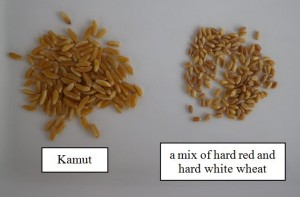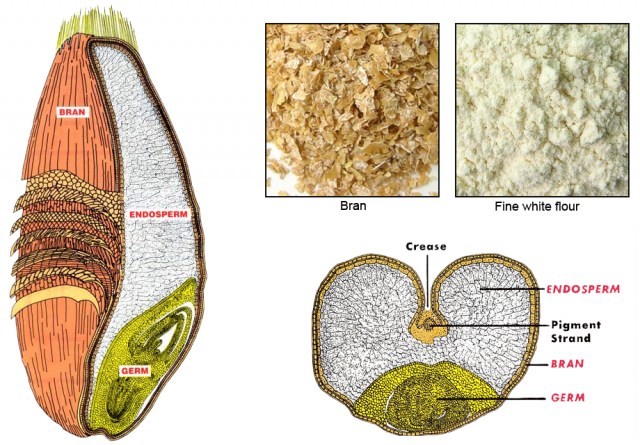Dear Hallee: Whole Wheat vs. Unbleached Flour
 Hello again, I know I always message you with cooking questions but I feel like you’re the only one who has the answer I am looking for. So here is my new question…What is unbleached flour? I understand the difference between wheat and white flour. With in the next year I am going to do my to try and make as much of every food my family will be eating. But I don’t quite know which flour I should be working with. Thank you so much…Melissa
Hello again, I know I always message you with cooking questions but I feel like you’re the only one who has the answer I am looking for. So here is my new question…What is unbleached flour? I understand the difference between wheat and white flour. With in the next year I am going to do my to try and make as much of every food my family will be eating. But I don’t quite know which flour I should be working with. Thank you so much…Melissa
White flour is actually bleached – they bleach it so that it will be whiter. Unbleached flour is what it sounds like – unbleached.
Here’s the thing about flour: Wheat in its original state has a perfect preserving form. The exterior shell (which is full of nutrition) protects the interior — in the Bible we even read of Joseph storing grain for 14 years. But, once that shell is cracked, the oils and nutrients inside dissipate quickly and it spoils and becomes rancid. 24 hours after grinding wheat into flour, you’ve lost 40% of its nutrients; within 72 hours, you’ve lost 90%. The outer shell – the bran – is full of nutrients as well. But, “white” flour is just the endosperm from the inside, with the bran and germ removed.
 Prior to the 20th century, local mills only ground enough grain to meet the demands of the area on a daily basis. People would purchase enough flour just to get them through a few days, because once it was ground, it didn’t stay fresh and would actually become rancid. So, until then, people used flour that for the most part contained most of its natural ingredients.
Prior to the 20th century, local mills only ground enough grain to meet the demands of the area on a daily basis. People would purchase enough flour just to get them through a few days, because once it was ground, it didn’t stay fresh and would actually become rancid. So, until then, people used flour that for the most part contained most of its natural ingredients.
Today, manufactured flour is “enriched” with vitamins and nutrients — added back into the flour. Fresh ground whole wheat contains 25 nutrients; “enriched” flour contains just a few vitamins that get added back in.
All that said, store-bought whole wheat four and unbleached flour aren’t too different nutritionally because of the loss of nutrients in the milling process. When wheat is ground for commercial flour sales, the bran is first removed and the germ and oil are removed because they are what cause the flour to spoil and become rancid. The remaining endosperm is then finely ground, leaving white flour. In order to market “whole-wheat flour,” a small percentage of the bran is returned to the product.

(Image source)
I use fresh ground, WHOLE wheat, and I use it as soon as it’s ground, which allows my family to benefit from all of the nutrients in the wheat given to us by God. All of my recipes that contain whole wheat are made with fresh ground wheat. My friends who have talked to me about the recipes that they make and how the results are not the same as mine, have used store-bought whole wheat. It’s dense, heavy, and doesn’t have any more health benefit than unbleached flour — other than some added fiber.
If it were me, I’d cook with unbleached flour — and I would use organic unbleached flour like Hodgsons Mill or King Arthur. I realize that is more expensive than just plain white flour, but your family will benefit more from it.
Hallee
I’m so grateful for your visit, today.
You would bless me if you added me to your ![]() feed reader or subscribed
feed reader or subscribed  via email.
via email.
You can also become a fan on ![]() Facebook or follow me on
Facebook or follow me on ![]() Twitter. I would love to see more of you!
Twitter. I would love to see more of you!


What you say about store-bought whole wheat flour being just white flour with the bran and germ removed and some bran added back – do you have a source for that?
http://thewholetruth.org/Health_Wheat_FAQ.asp#3
King Arthur flour customer service says that in making their whole wheat flour they grind the whole grain and don’t separate the fractions. Bob’s Red Mill says the same thing.
I would believe it with those companies. I don’t think I’d buy a grain product commercially from many other companies. You’re still looking at a loss of nutrients from time, and you’re still looking at a very heavy product with which to cook. I’d still say use at least half and half with unbleached white flour when using good commercial whole wheat, because using only whole wheat isn’t going to have as good of a result with most recipes.
Hallee, I guess my “gut” feeling was right. For ages I’ve felt that unbleached white is a better alternative that the typical whole wheat flour, which is probably rancid. That vitamin E and other good stuff in the wheat germ oil does not stay fresh long…
Before our old stone-grinder mill died, we could make excellent cookies with fresh-ground whole wheat flour. They were delicious. Sadly, throwing some finely-ground bran into white flour doesn’t really make it “whole”. THAT is an outrage! Where’s the truth in that advertising?!
Interesting that it’s becoming evident that, with our “modern diet”, we need the extra nourishment provided by things like fresh-ground flax seeds and such. We’ve had a healthy-oil deficit, thanks to the processing of that lovely “whole” wheat flour (and other things)…
Thanks for the post. I’d suspected, just never was sure.
Hi,
I’m a freelance journalist writing about grinding flour at home and I’ve used the following quote in my article. I got it from another source, but that person cannot verify it. I’m wondering if you can tell me where it comes from.
Thanks.
24 hours after grinding wheat into flour, you’ve lost 40% of its nutrients; within 72 hours, you’ve lost 90%
Hallee I need to change flours for what I cook because of my diabetes. I have just using all-purpose or self-rising bleached flour. Knowing whole wheat bread and such does much better on my sugar levels, I was considering using whole wheat flour but now I wonder if unbleached would be just as beneficial to me as the whole wheat. Any ideas or info you can share? Thanks!
I don’t know, honestly. I’m not sure how to answer that, because as diabetic, your body doesn’t do something necessary to survival properly, so rules change for you. I would say use the whole wheat, but make sure that the brand is a good one (like King Arthur or such).